Utagawa KUNIYOSHI (1797-1861)

Click here to view image full size.
Sasai Kyuzo Masayasu enveloped in smoke and avoiding musketry at the battle of Anegawa. The best design from the set Taiheiki yeiyuden, “Heroic Stories of the Taiheiki.” A history of the wars of the loyalist Nitta and Kusunoki families against the Ashikaga war-lords during the second quarter of the 14th century. But in fact the subject of this set of fifty prints is the civil war of the late 16th century. Censorship restrictions imposed in the 1840s prevented publishers from illustrating historical subjects from the Tensho era 1573-92 onwards, so the publishers circumvented this by slightly altering the names of the historical figures. Published 1848-9 by Yamamoto-ya Heikichi. Robinson S62.36.
Fine impression and colour. Very good condition. Signed Ichiyusai Kuniyoshi ga.
Status: Sold
Utagawa KUNIYOSHI (1797-1861)

Click here to view image full size.
Shows Hatsuhana’s long penance under the Tonozawa waterfall to aid her crippled husband “Hazari” Katsugoro who is intent on revenging his brother’s murder. Hatsuhana dies, Katsugoro is cured and kills his arch enemy near the waterfall. From the set Kenjo reppuden, “Stories of Wise and Virtuous Women.” Published by Ibaya Sensaburo, 1841-2.
Very fine impression and colour. Several small expertly repaired wormholes, otherwise very good condition. Signed Ichiyusai Kuniyoshi ga.
Status: Sold
Utagawa KUNIYOSHI (1797-1861)
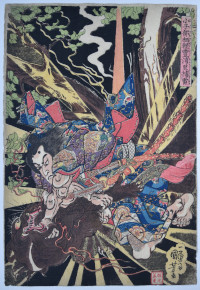
Click here to view image full size.
Koshibe no Sugaru amidst a thunderbolt and lightning captures a raiju (thunder monster) in the village of Toyora. Toyora no sato ni rai o torau. Its body was composed of lightning and usually in the form of a wolf or dog. Its cry sounded like thunder. Raiju is the companion of Raijin, the Shinto god of lightning. Although normally tranquil, during thunderstorms it became agitated and attacked trees. (Those that are struck by lightning are said to have been scratched by Raiju’s claws.) He presented it to the Emperor. Published by Nishimura-ya Yohachi, c. 1834-5. Robinson SIc.2. A wonderful design.
Superb impression. Very fine colour and condition. Signed Ichiyusai Kuniyoshi ga.
Status: Sold
Utagawa KUNIYOSHI (1797-1861)

Click here to view image full size.
Shows Matsuura Sayohime at the top of Kagami Mountain at Matsuura sadly watching her departing husband, Otomo no Sadehiko, on his way to Korea. It’s told she prayed with such fervour that she was turned to stone. From the set Kenjo reppuden, “Stories of Wise and Virtuous Women.” Published by Ibaya Sensaburo, 1841-2.
Very fine impression, colour and condition. Signed Ichiyusai Kuniyoshi ga.
Status: Sold
Utagawa KUNIYOSHI (1797-1861)

Click here to view image full size.
Kaneko Kugutsune (aka Okane, Kane-jo, and Omi no Okane) from the set Chuko meiyo kijin den, “Stories of Remarkable Persons of Loyalty and High Reputation.” Published by Iseya Ichiemon or Enshuya Matabei (this design) 1845. Robinson S35.5. Known as the Strong Woman of Omi, she is credited with subduing a runaway horse by holding its rein down with her geta. She is shown here with her washtub, the wild horse in the background.
Superb impression and colour. Very slight crinkling , trimmed close and some small wormage, otherwise fine condition. Signed Cho-o-ro Kuniyoshi ga.
Status: Sold
Utagawa KUNIYOSHI (1797-1861)

Click here to view image full size.
Musashi-bo Benkei of herculean strength subdued by the young Onzoshi Ushiwaka Maru (Yoshitsune) on Gojo Bridge. The story relates how Benkei (1155-1189) wandered around Kyoto with the intention of relieving 1000 samurai of their swords. One night with one more sword to go he saw Yoshitsune playing a flute and wearing a golden sword at the Gojotenjin Shrine. They agreed to fight on Gojo Bridge in southern Kyoto. However, Yoshitsune was too agile for Benkei and had been educated in the secrets of fighting by the tengu. Following Yoshitsune’s victory Benkei became Yoshitsune’s retainer. Published by Tsutaya Kichizo, c. 1843.
Fine impression and colour. Slight trimming, otherwise very good condition. Signed Ichiyusai Kuniyoshi ga.
Status: Sold
Utagawa KUNIYOSHI (1797-1861)
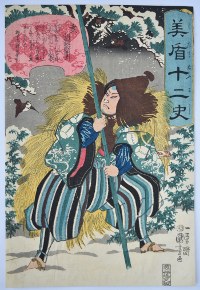
Click here to view image full size.
Yamamoto Kansuke striding through the snow. “Boar” from a set Mitate junishi, “Selection for the Twelve Signs.” Published by Ibaya Kyubei, c 1845. (Kansuke was famous for killing a giant boar in the snow.) Robinson S38.12.
Fine impression, colour and condition. Signed Ichiyusai Kuniyoshi ga.
Status: Sold
Utagawa KUNIYOSHI (1797-1861)

Click here to view image full size.
The death of the Daimyo Imagawa Yoshimoto (1519-60) by Oda Nobunaga during the battle of Okehazama which was fought at night during an intense downpour and was the culmination of the feud between the Imagawa and Oda clans. The battlefield is now a park and a national historical site. The best design from a set Yobu hakkei, “Military Brilliance of the Eight Views.” Each print relates to the famous Eight Views theme, in this case Narumi yau, “Night Rain at Narumi.” Published by Enshuya Hikobei, 1852.
Fine impression, colour and condition. Full size with extra paper left and top, which is unusual as these prints are normally trimmed from albums. Signed Ichiyusai Kuniyoshi ga.
Status: Sold
Utagawa KUNIYOSHI (1797-1861)

Click here to view image full size.
The fifteen year old Otani Furuinosuke killing a giant boar with his bare hands. From a set Honcho Suikoden goyu happyakunin no hitori, “One of the Eight Hundred Heroes of the Water Margin of Japan.” Published by Kagaya Kichiemon c 1831. This is the first edition: It was republished by Ibaya Sensaburo in 1845. Robinson S4a.14.
Fine impression and colour. Slight trimming at left, otherwise very good condition. Signed Ichiyusai Kuniyoshi ga.
Status: Sold
Utagawa KUNIYOSHI (1797-1861)

Click here to view image full size.
A complete diptych showing Miyamoto Musashi dressed for travelling looking across at Sasaki Kojiro who stands in profile with clenched fist. These two great swordsmen agreed to fight on April 13, 1612, on Ganryu Island off the coast of Bizen Province. The outcome was that Musashi killed Kojiro. From a set of prints Kendo ryaku den “Abridged Stories of Our Country’s Swordsmamship.” Published by Kadzusa-ya Iwazo, c. 1845-6. Robinson S37.16.18. The complete diptych is rare.
Very fine impression, colour and condition. Signed Ichiyusai Kuniyoshi ga.
Status: Sold
Utagawa KUNIYOSHI (1797-1861)

Click here to view image full size.
Jigoku Dayu, the “Hell Courtesan” from the set Chuko meiyo kijin den, “Stories of Remarkable Persons of Loyalty and High Reputation.” Published by Iseya Ichiemon or Enshuya Matabei (this design) 1845. Robinson S35.3. She was a courtesan who found enlightenment through the Buddhist monk Ikkyu. (The fly-whisk she holds denotes her enlightenment.) Sold to a brothel, she believed her misfortune was due to karma and is always depicted with robes depicting images of hell.
Very fine impression and colour. Very slight crinkling and trimmed close, otherwise fine condition. Signed Ichiyusai Kuniyoshi ga.
Status: Sold
Utagawa KUNIYOSHI (1798-1861)

Click here to view image full size.
A triptych Gishi shiju shichi-nin hommo wo toge…. Shows the Forty-seven Ronin crossing Ryogoku bridge with the head of their enemy while on the way to the Memorial Temple after carrying out their revenge. Yuranosuke bows to a mounted official on the near side. Published by Yamamoto-ya Heikichi , c.1847-50.
Fine impression. Very good colour. Slight thinning on first sheet, otherwise very good condition. Signed Ichiyusai Kuniyoshi ga.
Status: Sold
Utagawa KUNIYOSHI (1797-1861)
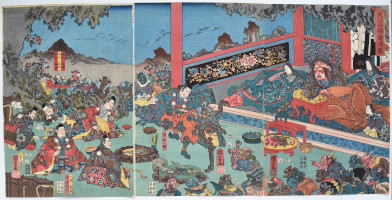
Click here to view image full size.
A triptych showing Shutendoji’s palace on Mount Oyeyama, Oyeyama fukujin shusei. Raiko (Minamoto no Yorimitsu) is charged by the Emperor Murakami with killing the evil Shutendoji who terrorizes the neighbourhood. He and his retainers infiltrate the castle and ply Shutendoji and his ogrish band with sake and dance for them. Eventually Shutendoji is so intoxicated he has to be carried to bed, whereupon Raiko and his followers attack and decapitate him. This is the episode most often depicted with the head flying through the air. Published by Kiya Sojiro, 1853.
Very good impression, colour and condition. Signed Ichiyusai Kuniyoshi ga.
Status: Sold
Utagawa KUNIYOSHI (1797-1861)

Click here to view image full size.
The heavily tattooed bandit Tanmeijiro Genshogo grappling with an adversary under water. One of the great designs from Tsuzoku Suikoden goketsu hyakuhachi-nin no hitori, “The Hundred and Eight Heroes of the Popular Suikoden, One by One.” Genshogo was famous for his tattoos and for the ability to stay under water for long periods. This large set and accompanying designs from the same period was a turning point in Kuniyoshi’s career. Published by Kagaya Kichibei, 1828-9. Robinson S2.69.
Fine impression and colour. Slight thinning of paper towards top; very slight centre fold and minimal soil at top, but otherwise fine condition. Alternate, later impressions lose the beautiful gradation in the water. Signed Ichiyusai Kuniyoshi ga.
Status: Sold
Utagawa KUNIYOSHI (1797-1861)

Click here to view image full size.
The brigand Saginoike Heikuro Masatora plunging a short sword into a giant boar. He is usually depicted battling a giant snake. Published c 1834-5 by Sanoya Kihei. Republished by Uedaya Kyujiro. Robinson S1c.17.
Very good impression and colour. The title label at extreme left edge trimmed and slight centre fold, otherwise good condition. Signed Ichiyusai Kuniyoshi ga.
Status: Sold
Utagawa KUNIYOSHI (1797-1861)

Click here to view image full size.
The general Morozumi Masakiyo, Lord of Bungo and a retainer of the Takeda Clan (Shingen of Kai Province) in a battle with the Uesugi Clan (Kenshin of Echigo Province), the wars taking place between 1553 and 1563. From a set Koetsu yusho den, “Stories of Courageous Generals of the Provinces of Echigo and Kai.” Masakiyo is shown committing suicide by inserting his sword into his mouth while being blown up by a land-mine. As with so much in Japan, the land-mine originated in China from early times. Published by Sumiyoshiya Masagoro, c. 1848-9. One of the “three great deaths” of these wars. A fine design.
Fine impression and colour with extensive sprayed pigment around the exploding mine. Trimmed slightly on the right, otherwise very good condition. Signed Ichiyusai Kuniyoshi ga.
Status: Sold
Utagawa KUNIYOSHI (1797-1861)

Click here to view image full size.
The best design from Genji kumo Ukiyoe awase, “Ukiyoe Comparisons of the Cloudy Chapters of Genji.” A set comparing famous warriors to the Chapters of the Genji Monogotari written by Lady Murasaki Shikibu (c 973-1025). This design is for Chapter 22, Tamakatzura. Shows the pearl diver, Tamatori-hime, who has reclaimed the precious pearl stolen by the Dragon King. She is pursued by a host of his aquatic retainers including a giant octopus before finally returning the jewel to her husband Fujiwara no Kamatari, albeit buried in her chest for safety and causing her death. A popular subject with Kuniyoshi who designed a number of other oban prints and triptychs on this subject. The Dragon King’s Palace can be seen beneath the waves in the background. Published by Iseya Ichibei, 1843-5.
Fine impression and colour. Slight crinckling in margins, otherwise very good condition. Signed Ichiyusai Kuniyoshi ga.
Status: Sold
Utagawa KUNIYOSHI (1797-1861)
Click here to view image full size.
A triptych showing Kato Kiyomasa (Watoni) and his henchmen watching Korean man-eating tigers carrying off their compatriots across a river. Watoni gunko toshu no zu. Hideyoshi sent Kiyomasa to Korea twice in 1592 and 1597. He is often depicted killing a man-eating tiger. Published by Yamaguchi-ya Tobei in 1855.
Very early fine impression with beautiful colour variation on the rocks at right. Fine colour. Slight edge crease near left edge of first sheet and imperceptible centre folds, otherwise very good condition. Signed Ichiyusai Kuniyoshi ga.
Status: Sold
Utagawa KUNIYOSHI (1797-1861)
Click here to view image full size.
Nanke yushi Shijo-nawate nite uchijini. The last stand of the Kusunoki clan at Shijo-nawate in 1348. Kusunoki Masatsura, shown on the far left propped against his fallen horse under a rain of arrows, continues his father’s struggle against the Ashikaga forces. Wada Shinbochi (Genshu) leads the way holding enemy heads followed by Masatomo with a battle standard. Their blue complexions anticipate their imminent demise. Published by Fujioka-ya Keijiro, 1851-2. Robinson T271.
Fine impression. One small backed wormhole on title, otherwise very good condition. Full size. Signed Ichiyusai Kuniyoshi ga.
Status: Sold
Utagawa KUNIYOSHI (1797-1861)
Click here to view image full size.
A triptych showing Ushiwaka Maru (Minamoto no Yoshitsune’s childhood name), attended by Kisanda, practising fencing with the karasu or “crow” tengu in a forest glade on Mt Kurama, north of Kyoto. His training in martial arts is being supervised by a white-bearded yamabushi tengu, Sojobo, King of the Tengu. (The yamabushi were followers of Shugendo – a shamanistic mountain ascetism.) Yoshitsune (1159-1189) is the best known Japanese warrior and a popular subject for Japanese artists and craftsmen. Famous for exploits such as the battle on Gojo Bridge with Benkei and the battle of Dan-no-ura. Published by Enshuya Hikobei, 1851-2. Robinson T264.
Fine impression. This is the first state with gradation on the rocks top left. Fine colour. Very good condition. Signed Ichiyusai Kuniyoshi ga.
Status: Sold
Utagawa KUNIYOSHI (1797-1861)
Click here to view image full size.
An extremely rare diptych showing Princess Wakana (left) played by Bando Shuka I and the warriors Genkai Nadaemon played by Arashi Rikan III; Washizu Rokuro played by Arashi Rikaku II; Wachizu Shichoro played by Bando Takesaburo I. The play Shiranui monogatari, “The Tale of the White Embroiderer” was performed at the Kawarazaki Theatre, 2/1853. The story (from a late Edo novel) tells of the feud between Wakana and the Kikuchi clan who killed her family. She is rescued by a spider who gives her the power of spider magic which, with the aid of a spider scroll, enables her to conjure up a giant spider to assist her. Published by Kakumoto-ya Kinjiro. This is the only complete impression I have seen and I can only find one other recorded example (listed in the Kuniyoshi Project).
Fine impression and colour. Small edge binding holes, otherwise fine condition Signed Ichiyusai Kuniyoshi ga.
Status: Sold
Utagawa KUNIYOSHI (1797-1861)
Click here to view image full size.
The stern of a large sailing-junk and a smaller vessel infront. A poem by Sangi Takamura (Ono no Takamura) from Hyaku-nin isshu, “The Hundred Poets” published by Ebine c 1838. Depending which story one reads, either Takamura, who was a customs official for ships trading to and from China, went missing on a mission or was reported for being an extortioner and banished to the Oki Islands. Either way, he was subsequently pardoned. One of the best designs from this fine set. Robinson S19.11 and illustrated in Robinson (1961), no. 59.
Fine impression. Very good colour. Remargined top and bottom, otherwise very good condition. Signed Ichiyusai Kuniyoshi ga.
Status: Sold
Utagawa KUNIYOSHI (1797-1861)
Click here to view image full size.
Daimotsu-no-ura o-kassen. A triptych showing the battle of Dan-no-ura. The clash between the Minamoto (Genji) clans and the Heike (Taira) clans happened in 24/3/1185 when the Taira were defeated by Yoshitsune. He is shown here on the left making his leap pursued by Noritsune. The Imperial barge is in the background. Published by Moriya Jihei, 1856. Robinson T337.
Fine impression and colour. Slight trimming, otherwise very good condition. Signed Ichiyusai Kuniyoshi ga.
Status: Sold
Utagawa KUNIYOSHI (1797-1861)
Click here to view image full size.
A triptych showing the ghosts of the Taira (Heike) warriors attempting to sink Yoshitsune’s ship off the coast of Settsu on his way to Shikoku. This is one of Kuniyoshi’s great designs – amongst the three or four best triptychs and is illustrated in numerous publications. The scene is the outcome of a great battle at Dan-no-ura where the Minamoto (Genji) clans clashed and defeated the Taira clans a few years earlier. The spirits of the drowned warriors rose up to seek revenge only to be pacified by Benkei reciting exorcisms with his rosary. Published 1849-52 by Enshuya Hikobei. Robinson T242. Rare.
Very good impression and colour although slightly mismatched blue on the first and second sheets. Very good condition. Full size. There appear to be three states of this design: The main difference being in the shape of the ghosts and lines in the waves only on the first state. In this (the second state) the ghosts lack some of the features that are on the first and a large spirit appears above the wave over the ship on the centre panel. The third state has further differences in the ghosts and lacks this figure. Also, the colour of the boat gets greyer. Signed Ichiyusai Kuniyoshi ga.
Status: Sold
Utagawa KUNIYOSHI ( 1797-1861 )
Click here to view image full size.
Kwatsuyemra Genshoshichi hiding under a tiger-skin in a boat under a hail of arrows. From Tsuzoku Suikoden goketsu hyaku-hachi-nin no hitori, “The Hundred and Eight Heroes of the Popular Suikoden, One by One.” Published by Kaga-ya Kichiyemon, c 1827-30. Robinson S2.40.
Fine impression and colour. Very good condition: completely untrimmed. Signed Ichiyusai Kuniyoshi ga.
Status: Sold
Utagawa KUNIYOSHI ( 1797-1861 )
Click here to view image full size.
Saito Toshimoto and a Chinese general struggling underwater. The second best design from Taiheiki yeiyu den, “Heroic Stories of the Taiheiki.” Published by Yamamoto-ya Heikichi, 1848-9. Robinson S62.31.
Extremely fine impression of the earliest printing. ( This is the best example I have seen of this design. ) Fine colour and condition. Signed Ichiyusai Kuniyoshi ga.
Status: Sold
Utagawa KUNIYOSHI ( 1797-1861 )
Click here to view image full size.
The last stand of the Kusunoki at Shijonawate, Shijonawate nite Nanke no eiyu taiteki o. Shows the final battle of Shijonawate in 1348 with Kusunoki Masatsura, the son of Kusunoki Masashige, under a deluge of arrows continuing his father’s struggle against the Ashikaga forces. This forms a 6-sheet composition with another triptych and Kuniyoshi also designed another triptych of the same subject. Published 1847. Unidentified publisher.
Very fine impression of the earliest printing. Very fine colour. Fine condition. Signed Ichiyusai Kuniyoshi ga.
Status: Sold
Utagawa KUNIYOSHI ( 1797-1861 )
Click here to view image full size.
The priest Nichiren standing on the rocky promontory at Reizan in Kamakura and having his prayers for rain answered. The event occurred in 1271. His disciples surround him and protect him from the deluge with a large umbrella. Bunei hachi Kamakura Reizan-ga-saki uki. The second best design from Koso [ Nichiren ] goichidai ryakuzu, “Illustrated Abridged Biography of the Founder.” Nichiren ( 1222 – 1282 ) was the founder of the Buddhist Nichiren sect ( Nichiren shu – Kuniyoshi being a follower ) and indeed the set of ten prints may have been commissioned to mark the 550th anniversary of his death. Published by Iseya Rihei c 1831.
Fine impression. Very good colour and condition. This design is notorious for having the umbrella trimmed off and/or the title in right margin. The printer has compensated for this by printing close to the left border. Signed Ichiyusai Kuniyoshi ga.
Status: Sold
Utagawa KUNIYOSHI ( 1797-1861 )
Click here to view image full size.
A triptych showing the old hag of Hitotsuya in the dilapidated house on Adachi Moor. The morbid story tells of a woman who developed cannibalistic habits for the lord of the district who required the blood of babies or young women. The hag menacies a young girl while Kannon ( to the right ), the goddess of compassion, looks on. In fact these are life-like dolls ( iki-ningyo ). There were popular exhibitions of these dolls during the mid 1850s to the late 1860s. Leading exponents being Yasumoto Kamehachi and Matsumoto Kisaburo. The latter had an exhibition in Asakusa Okuyama in 1855 and this might have been one of the exhibits. Kuniyoshi designed a number of diptychs and triptychs showing various exhibits of these dolls including others on this subject. Published 2/1855 by Yamaguchiya Tobei.
Very good impression, colour and condition. Signed Ichiyusai and Cho-o-ro Kuniyoshi ga.
Status: Sold
Utagawa KUNIYOSHI ( 1797-1861 )
Click here to view image full size.
Kyusempo Sakucho at the battle of Peking from Tsuzoku Suikoden goketsu hyaku-hachi-nin no hitori, “The Hundred and Eight Heroes of the Popular Suikoden, One by One.” Shows the brigand wielding a huge axe and plunging through deep snow on his horse. Published by Kaga-ya Kichiyemon, c 1827-30. Robinson S2.44.
Very good impression and colour. Slight trimming, otherwise very good condition. Signed Ichiyusai Kuniyoshi ga.
Status: Sold
Utagawa KUNIYOSHI ( 1798-1861 )
Click here to view image full size.
Hidesato ( Fujiwara no ) commonly called Tawara Toda. Having killed the giant centipede for Ryujin, the Dragon King, he is shown accompanied by a host of fishy retainers riding the back of a giant turtle and with the gifts which were his reward: The giant bell ( subsequently given to the monastery of Miidera where it was stolen by Benkei ); a bag of rice which could not be exhausted; a cooking pot which didn’t need fire ( sometimes omitted ), and a roll of silk which could not be shortened by cutting. Above the waves in the distance can be seen the entrance to the Dragon King’s palace. Published 1858 by Maruya Kyoshiro.
Very fine impression showing wood grain. Perfect gradation. Fine colour. Very slight trimming, otherwise fine condition. Signed Ichiyusai Kuniyoshi ga.
Status: Sold
Utagawa KUNIYOSHI ( 1798-1861 )
Click here to view image full size.
Minamoto Tametomo decapitating Yamaotoko – a creature descended from a devil. From a set of ten prints: Tametomo homare no jikketsu, “Ten Famous Glories of Tametomo.” Published by Aritaya Seiemon 1847-50.
Fine impression, colour and condition. Signed Ichiyusai Kuniyoshi ga.
Status: Sold
Utagawa KUNIYOSHI (1798-1861)
Click here to view image full size.
A complete diptych showing Inuzuka Shino and Inukai Kempachi on the Horyukaku roof from Satomi Hakkenden, the eight heroes of Bakin’s novel Hakkenden. Published by Mikawa-ya Tetsugoro, c 1849-51. See the Kunichika triptych of the same subject on this current selection. Rare complete.
Very good impression, colour and condition. Signed Ichiryusai Kuniyoshi ga.
Status: Sold
Utagawa KUNIYOSHI (1798-1861)
Click here to view image full size.
An oban diptych showing the two heroes, Inuyama Dosetsu Tadatomo ( seated ) and Inukawa Sosuke Yoshito. Chapter 22 from Bakin’s famous book of the Eight Dog Warriors. From a yellow-ground set: Honcho kendo ryaku den, “Abridged Stories of Our Country’s Swordsmanship.” Published by Kadzusa-ya Iwazo, c 1845-6. Robinson S37.7 & 9. Rare as the design is seldom found complete.
Very fine impression, fine colour and condition. Signed Ichiyusai Kuniyoshi ga.
Status: Sold
Utagawa KUNIYOSHI (1798-1861)
Click here to view image full size.
An early design of a famous episode depicting Raigo Ajari ( the priest Jitsusobo ) breathing out his curses and tearing up the Buddhist scrolls of Miidera Temple. His curses are directed at the Emperor Shirakawa who had refused the granting of a favour to build a praying platform at his temple in return for Raigo praying successfully for a son for the Emperor. Published by Jo-Yasu, c 1843. Robinson S1f.5. A fine and rare design.
Very good impression and colour. Slight trimming, otherwise very good condition. Signed Ichiyusai Kuniyoshi ga.
Status: Sold
Utagawa KUNIYOSHI (1798-1861)
Click here to view image full size.
The super-strong small boy Kintaro ( Kaido-maru ) wielding a giant axe and with his forest companions a bear-cub and a monkey. One of Kuniyoshi’s finest designs from Rokuyosei Kuniyoshi jiman, “Six Conditions of Nature.” This design: Tai-an: A good day for travelling. Published by Uoya Eikichi, year of the monkey, 1860. Robinson S93.3.
Superb impression of the first edition with polishing and gauffrage on the bear-cub. Fine colour. Minimal trimming, otherwise fine condition. Signed Ichiyusai Kuniyoshi ga.
Status: Sold
Utagawa KUNIYOSHI (1798-1861)
Click here to view image full size.
One of Kuniyoshi’s finest designs from Rokuyosei Kuniyoshi jiman, “Six Conditions of Nature.” This design: Sembu: Not a very lucky day. Shows Mongaku ( Endo Morito, c. 1120 – 1200 ) subjecting himself to three years penance as a Buddhist monk beneath the waterfall of Mount Nachi in Kii Province. Morito inflicted this punishment on himself because he had inadvertently cut off the head of Kesa Gozen, the wife of the palace guard Watanabe Wataru, with whom he was in love. This subject lends itself to some wonderful designs: See this website for a rare horizontal triptych by Yoshitoshi and a vertical triptych by Kuniyoshi, and there are many single sheets by various artists. Published by Uoya Eikichi, year of the monkey, 1860. Robinson S93.4 and illustrated in colour, pl. 29, Kuniyoshi: The Warrior-Prints, Phaidon, 1982. Rare.
Superb impression of the first edition with splashed gofun. Fine colour. Minimal trimming, otherwise fine condition. Signed Cho-o-ro Kuniyoshi ga.
Status: Sold
Utagawa KUNIYOSHI (1798-1861)
Click here to view image full size.
Tamatori-hime stealing the sacred jewel from the Dragon King’s Palace, Ryugu Tamatori-hime no zu. Published by Yamaguchiya Tobei, Ox 6, 1853. The ama is shown being pursued by the Dragon King and his various fishy retainers. This was a favourite subject of Kuniyoshi’s and he designed a number of triptychs and single sheets. A wonderful and rare design.
Fine impression and colour. Extensive splashed gofun. Trimmed round, otherwise very good condition. Signed Chooro Kuniyoshi ga and Ichiyusai Kuniyoshi ga.
Status: Sold
Utagawa KUNIYOSHI (1798-1861)
Click here to view image full size.
Saginoike Heikuro from Honcho Suikoden goyu happyaku-nin no hitori, “Eight Hundred Heroes of our Country’s Suikoden, One by One.” Shows the brigand wrestling with a huge serpent at the Lake of Sayama ( or Hazama ) at Tondabayashi in the Province of Kawachi. Published by Ibaya Sensaburo, c 1845. Robinson S4b.4. Fine design.
Very good impression and colour. Full size. Slightly soiled bottom left, otherwise very good condition. Signed Ichiyusai Kuniyoshi ga.
Status: Sold



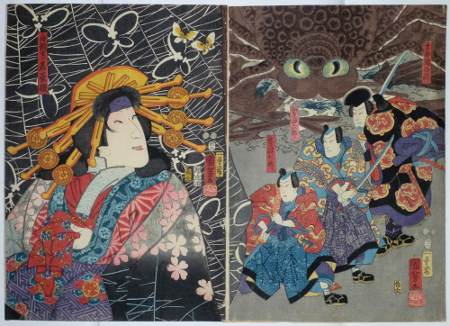






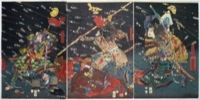


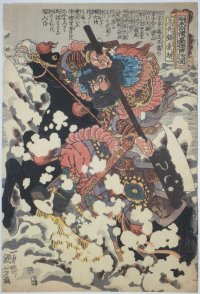


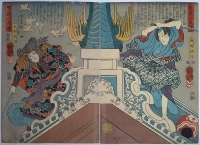
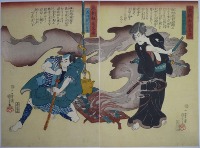
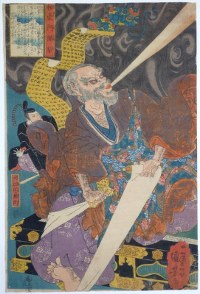

-warriors189_small.jpg)

